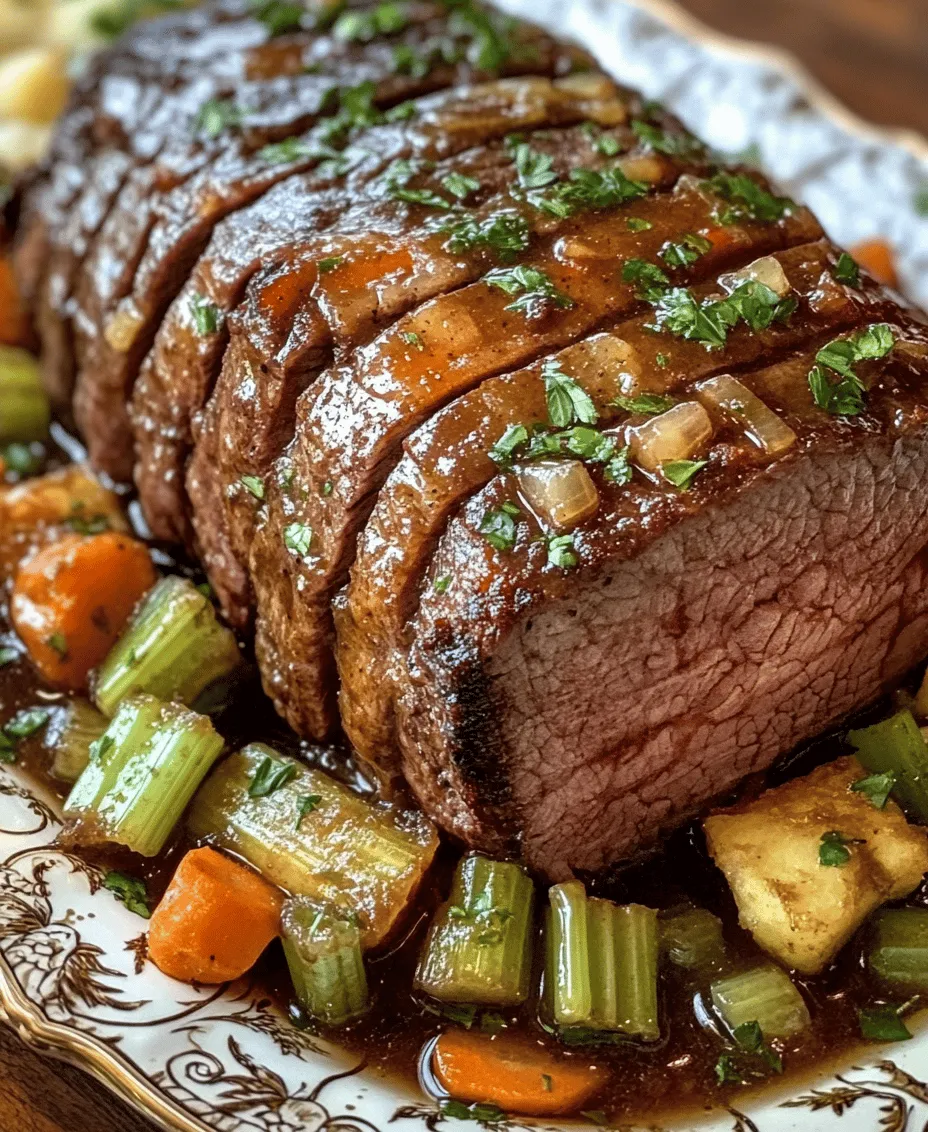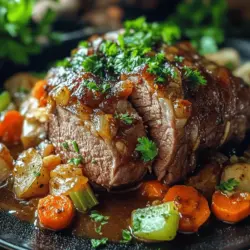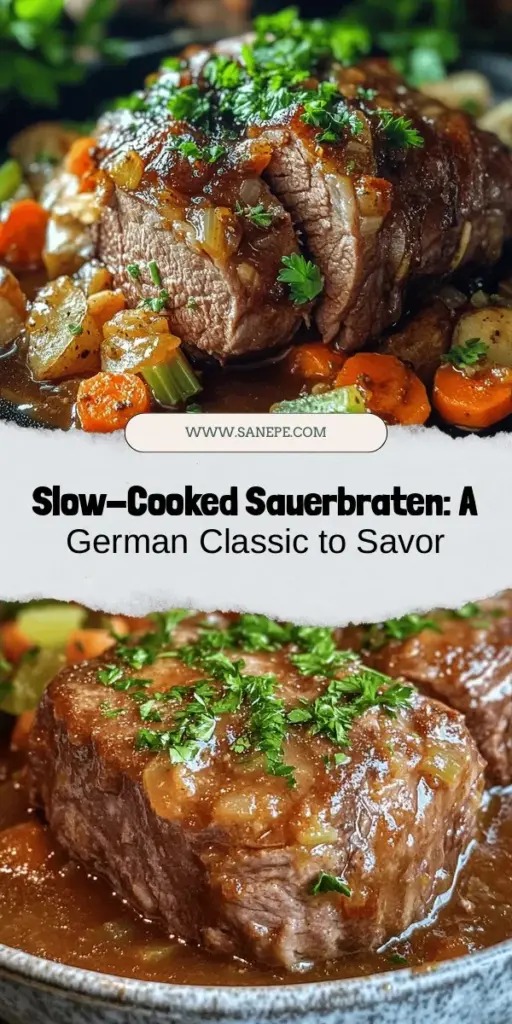Introduction
Sauerbraten, a traditional German dish, has captured the hearts and palates of many food lovers around the world. This hearty meal is not just a comforting plate of beef; it’s a celebration of culinary history, showcasing the rich flavors and techniques that define German cuisine. Often referred to as Germany’s national dish, Sauerbraten translates to “sour roast,” a name that pays homage to its unique marination process, which imparts a complex flavor profile and tender texture to the meat.
The appeal of slow-cooked recipes, like Sauerbraten, lies in their ability to transform simple ingredients into extraordinary meals. Cooking a dish low and slow allows flavors to meld beautifully, resulting in a tender, succulent roast that simply melts in your mouth. As the beef simmers, the aromatic blend of spices and vegetables permeates the meat, creating a dish that is both satisfying and deeply flavorful. Whether you’re preparing a festive dinner or a cozy family meal, Sauerbraten stands out as a timeless favorite.
This recipe for Sauerbraten not only embraces the traditional preparation methods but also celebrates the versatility and depth of flavors that have made it a staple in German households for centuries. With roots stretching back to the Middle Ages, Sauerbraten has evolved over time, with each region of Germany putting its own spin on the classic dish. In this article, we will explore the history of Sauerbraten, break down the essential ingredients, and guide you through each step of the preparation process.
Understanding Sauerbraten
Sauerbraten is more than just a meal; it’s a reflection of German culture and traditions. Historically, the dish was a way to preserve meat by marinating it in a mix of vinegar and spices, allowing it to develop a tangy flavor while also extending its shelf life. This method of preservation was especially important in rural areas where refrigeration was not available. The marination process softens the tough cuts of beef, making them tender and flavorful.
The cultural significance of Sauerbraten varies across different regions of Germany, each with its own unique take on the recipe. For instance, in the Rhineland, the dish is often prepared with a sweet and sour sauce made from raisins and brown sugar, while in Bavaria, you might find it served with a rich, dark gravy. These regional variations highlight the flexibility of Sauerbraten and how it can be adapted to different tastes and preferences.
At its core, Sauerbraten is defined by a few key ingredients that contribute to its distinct flavor. The primary component is a beef roast, typically a tougher cut like chuck or rump, which benefits greatly from the long cooking time. The marinade usually consists of red wine vinegar, water, and an array of aromatic vegetables and spices. This combination not only flavors the meat but also helps to tenderize it, making it a perfect candidate for slow cooking.
Ingredients Breakdown
When preparing Sauerbraten, selecting the right ingredients is crucial for achieving the authentic taste and texture associated with this classic dish. Here’s a breakdown of the main ingredients that define Sauerbraten:
Beef Roast Options: Chuck vs. Rump
The choice of beef cut plays a significant role in the final outcome of your Sauerbraten. Chuck roast is a popular choice due to its balance of meat and fat, which renders down during the slow cooking process, resulting in a juicy and tender roast. Rump roast, on the other hand, is leaner and can be more flavorful, but it may require careful cooking to avoid drying out. Both cuts work well for Sauerbraten, so the decision ultimately depends on your preference for meat texture and flavor.
Role of Red Wine Vinegar in Marination
Red wine vinegar is a defining ingredient in Sauerbraten, providing the tangy flavor that gives the dish its name. The acidity of the vinegar not only enhances the taste but also plays a crucial role in tenderizing the meat. During the marination process, the vinegar breaks down the proteins in the beef, resulting in a melt-in-your-mouth texture. It’s essential to use good-quality red wine vinegar, as it will significantly impact the overall flavor of the dish.
Importance of Aromatics: Onion, Carrots, Celery, and Garlic
Aromatic vegetables add depth and complexity to the Sauerbraten marinade. Onions are a staple in the recipe, providing a sweet and savory base. Carrots and celery contribute a hint of sweetness and earthiness, while garlic brings a robust flavor that complements the other ingredients. These vegetables not only enhance the taste but also infuse the meat with their natural juices as it cooks.
Spices and Their Contribution to Flavor: Whole Cloves, Peppercorns, Bay Leaves
Spices are critical in crafting the signature flavor of Sauerbraten. Whole cloves and peppercorns add warmth and a subtle hint of spice, while bay leaves provide an aromatic backdrop. The combination of these spices creates a flavor profile that is both rich and inviting. It’s important to use whole spices in the marinade, as they release their essential oils slowly, enriching the dish as it simmers.
The Role of Broth and Optional Thickening Agents
In addition to the marinade, broth is often used to enhance the saucy component of Sauerbraten. Beef broth adds depth and richness, complementing the flavors of the marinated meat. If you prefer a thicker sauce, you can incorporate a thickening agent such as cornstarch or flour towards the end of the cooking process to achieve the desired consistency.
Nutritional Information and Benefits of Key Ingredients
Sauerbraten, while indulgent, can also offer nutritional benefits. Beef is an excellent source of protein, iron, and essential vitamins, making it a hearty choice for a main dish. The inclusion of vegetables not only enhances the flavor but also boosts the fiber and vitamin content of the meal. When prepared with care, Sauerbraten can be a balanced and satisfying option for family dinners or special occasions.
Preparation Process
The preparation of Sauerbraten involves a few essential steps that are crucial for achieving the perfect roast. Here’s a detailed explanation of the marination process and the subsequent cooking techniques:
Detailed Explanation of the Marination Process
The first step in preparing Sauerbraten is to create the marinade. In a large bowl or container, combine red wine vinegar, water, and your choice of aromatics—onion, carrots, celery, and garlic. Add the whole spices, including cloves, peppercorns, and bay leaves, to the marinade. Next, place the beef roast in the marinade, ensuring it is fully submerged. If necessary, you can weigh the meat down with a plate to keep it immersed.
Importance of Marinating Time and Turning the Meat
For optimal flavor and tenderness, it’s crucial to allow the beef to marinate for at least 48 hours, although some enthusiasts recommend marinating for up to a week. This extended marination time allows the flavors to penetrate deeply into the meat. It’s also important to turn the meat occasionally during this period, ensuring that all sides are evenly coated with the marinade.
How to Properly Store and Seal the Marinade
To store the marinade, make sure to use an airtight container or a resealable plastic bag. This prevents any leaks and keeps the flavors intact. Place the container in the refrigerator, as the cool temperature is essential for food safety during the marination process. Always ensure that the meat is kept below 40°F (4°C) to avoid any risk of spoilage.
Searing the Roast: Techniques for Achieving the Perfect Crust
Once marinated, it’s time to cook the Sauerbraten. Start by removing the beef from the marinade, allowing any excess liquid to drip off. Pat the meat dry with paper towels to achieve a better sear. In a large, heavy-bottomed skillet or Dutch oven, heat a few tablespoons of oil over medium-high heat. Searing the roast on all sides until a deep brown crust forms is crucial, as this step adds a layer of flavor through the Maillard reaction. The rich, caramelized surface will enhance the overall taste of the finished dish.
The Science Behind Browning and Its Flavor Benefits
Browning the meat is not just about creating an appealing appearance; it’s also about developing complex flavors. The Maillard reaction occurs when the amino acids and sugars in the meat react to heat, resulting in a rich, savory flavor and darker color. This initial searing step is essential in building the foundation of taste that will carry through the slow cooking process.
As we move forward in this Sauerbraten journey, we will delve into the slow cooking method, the finishing touches that make this dish extraordinary, and tips to elevate your Sauerbraten experience even further. Stay tuned for the next part of this delicious and traditional German recipe!

Setting Up the Slow Cooker for Optimal Results
To achieve the best results with your Sauerbraten, proper preparation of your slow cooker is essential. Start by ensuring that your slow cooker is clean and functioning well. An ideal slow cooker for this recipe should have a capacity of at least 6 quarts, allowing enough room for the beef and marinade without crowding.
1. Layering the Ingredients: Begin by placing the vegetables, such as onions, carrots, and celery, at the bottom of the slow cooker. These will act as a natural rack for the beef, allowing the marinated flavors to permeate the meat evenly while preventing it from boiling in the liquid below.
2. Adding the Meat: Next, carefully place your marinated beef roast on top of the vegetables. If you have reserved some marinade, pour it over the meat, ensuring it is well-coated. This step is crucial for maximizing the infusion of flavors during the cooking process.
3. Incorporating Broth: Pour in beef broth or stock until the meat is partially submerged, about halfway. This will create steam and keep the meat moist while it slowly cooks. Using homemade broth adds another layer of flavor, but store-bought options work well too.
4. Final Touches: For an extra depth of flavor, consider adding aromatics like bay leaves, garlic cloves, or a sprinkle of whole peppercorns. These will enhance the overall taste of the sauce that develops beneath the roast.
Tips for Layering Flavors with the Marinade and Broth
To create a complex and rich flavor profile, layering your marinade and broth is key. Here are some tips:
– Marinate Effectively: Ensure that the roast marinates for at least 48 hours, turning occasionally to allow for even flavor absorption. The acidity from vinegar and the spices in the marinade act to tenderize the meat and impart deep flavors.
– Use High-Quality Ingredients: Fresh herbs, quality beef broth, and aromatic spices can make a significant difference. Ingredients like whole spices—such as cloves and allspice berries—release their oils slowly during cooking, enhancing the overall flavor.
– Flavor Boosters: Consider adding a splash of red wine or balsamic vinegar to the broth. This not only enhances the taste but also works well with the sweetness of the marinated beef.
Cooking Techniques
Slow Cooking vs. Other Cooking Methods: Why Slow Cooking is Preferred for Sauerbraten
Slow cooking is the preferred method for Sauerbraten due to its ability to transform tough cuts of meat into tender, succulent dishes. The low, steady heat breaks down the connective tissues in the beef, allowing it to absorb the flavors of the marinade and develop a rich, complex taste.
In contrast, traditional methods like roasting at high temperatures can result in a dry roast. High-heat cooking may not provide the same tenderizing effect, which is crucial for a dish like Sauerbraten that relies on the meat’s inherent flavor and texture.
Understanding the Cooking Times for Different Settings (Low vs. High)
Depending on your schedule, you can choose between low and high settings on your slow cooker:
– Low Setting: Cook for 8 to 10 hours. This setting is ideal for maximum tenderness, allowing the beef to become fall-apart soft while soaking up all the wonderful marinade flavors.
– High Setting: Cook for 4 to 6 hours. While this is a quicker option, it may not yield the same level of tenderness as the low setting. If you’re short on time, using high heat is acceptable, but plan to check the roast periodically to avoid overcooking.
Both methods can yield delicious results, but low and slow is the classic approach for this traditional dish.
Signs That the Roast is Perfectly Cooked and Tender
Knowing when your Sauerbraten is ready can be determined through a few key signs:
– Internal Temperature: Use a meat thermometer to check for an internal temperature of about 190°F to 205°F. At this temperature, the collagen in the meat has broken down, leading to a tender roast.
– Fork Test: If the meat easily pulls apart with a fork, it’s a sure sign that it’s ready to be served.
– Visual Cues: The meat should have a deep, rich color from the marinade, and the juices should run clear, indicating that it is fully cooked.
Creating the Gravy
After your Sauerbraten has finished cooking, it’s time to create a delicious gravy from the cooking liquid.
Step-by-Step Guide to Preparing the Gravy from Cooking Liquid
1. Strain the Liquid: First, carefully remove the beef from the slow cooker and set it aside to rest. Strain the cooking liquid through a fine mesh sieve into a saucepan. This eliminates any solid bits from the vegetables and spices.
2. Prepare for Thickening: Place the strained liquid over medium heat. Allow it to simmer, reducing the volume slightly to intensify the flavors.
3. Make a Slurry: In a small bowl, combine equal parts cornstarch and cold water (usually 1 tablespoon of each is sufficient). This mixture will help thicken the gravy without forming lumps.
4. Combine and Thicken: Gradually whisk the slurry into the simmering liquid. Continue stirring until the gravy reaches your desired thickness, typically around 5 minutes.
5. Adjust Seasoning: Finally, taste the gravy and adjust the seasoning with salt and pepper as needed. A touch of vinegar can help brighten the flavor, balancing the richness of the gravy.
Serving Suggestions
Ideal Accompaniments for Sauerbraten
When it comes to serving Sauerbraten, traditional accompaniments shine, but there is room for creativity as well.
– Traditional Sides: Classic pairings include buttery mashed potatoes, braised red cabbage, and fresh crusty bread. These sides not only complement the rich flavors of the beef but also help to soak up the delicious gravy.
– Creative Variations: For a modern twist, consider serving Sauerbraten with roasted root vegetables or a fresh arugula salad tossed with a light vinaigrette. These options add brightness and texture, providing a delightful contrast to the hearty roast.
Presentation Tips for a Beautiful Plating Experience
To elevate your Sauerbraten presentation, follow these simple tips:
– Slice Strategically: Cut the beef into uniform slices, showcasing the marbling and tenderness. Arrange them neatly on the plate.
– Drizzle with Gravy: Generously spoon gravy over the beef, allowing it to pool slightly on the plate for an inviting look.
– Add Color: Use steamed or roasted vegetables to add color to the plate. Bright red cabbage or vibrant green beans can create an appealing contrast.
– Garnish: A sprinkle of fresh parsley or chives adds a pop of freshness and color to the dish, making it visually appealing.
Storing and Reheating Sauerbraten
Best Practices for Storing Leftovers
Leftover Sauerbraten can be stored for later enjoyment. Follow these guidelines for optimal freshness:
– Cool Completely: Allow the beef and gravy to cool to room temperature before storing. This prevents condensation in the storage container, which can cause sogginess.
– Use Airtight Containers: Transfer the beef and gravy into airtight containers. They can be stored in the refrigerator for up to 3-4 days or frozen for longer shelf life, up to 3 months.
– Labeling: Don’t forget to label the containers with the date to keep track of freshness.
Methods for Reheating Without Losing Flavor or Texture
To reheat your Sauerbraten while maintaining its flavor and texture:
– Slow Cooker Method: Place the beef and gravy back into the slow cooker on low heat, allowing it to warm gradually. This method helps retain moisture and flavor.
– Stovetop Method: Reheat on the stovetop over low heat, stirring gently to prevent sticking. Add a splash of broth or water if the gravy appears too thick.
– Microwave Method: If you’re in a hurry, use the microwave. Place the beef and gravy in a microwave-safe dish, cover loosely, and heat in short intervals, stirring in between, until heated through.
Tips for Repurposing Leftovers in New Dishes
Leftover Sauerbraten can be creatively repurposed into new meals:
– Sauerbraten Tacos: Shred the beef and serve it in corn tortillas topped with fresh salsa and avocado for a fun twist.
– Beef Stroganoff: Use the leftover beef in a creamy stroganoff served over egg noodles. Just add some sour cream and mushrooms to the saucy goodness.
– Savory Beef Sandwiches: Slice the beef thinly and serve it on a crusty roll with a generous amount of gravy for a delicious sandwich.
Conclusion
Sauerbraten is more than just a meal; it’s a comforting homage to traditional cooking that brings warmth and flavor to any table. The slow-cooking process not only enhances the beef’s tenderness but also allows the rich, aromatic marinade to permeate every bite, resulting in a dish that is truly a delight.
We encourage you to try making this classic dish at home. With its deep flavors and satisfying textures, Sauerbraten is perfect for family gatherings or special occasions. Embrace the joy of cooking traditional recipes, and don’t forget to share this culinary experience with your loved ones. The rich flavors and comforting nature of Sauerbraten make it a meal to remember, and the memories created around the dinner table will last a lifetime. Happy cooking!


